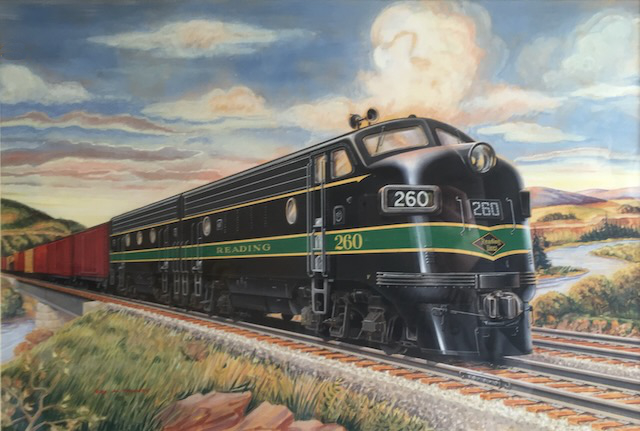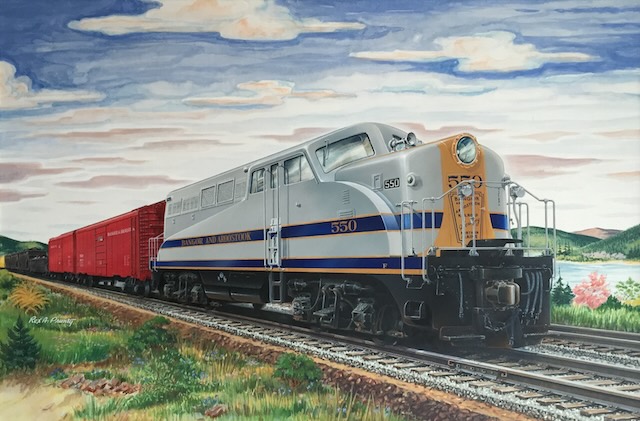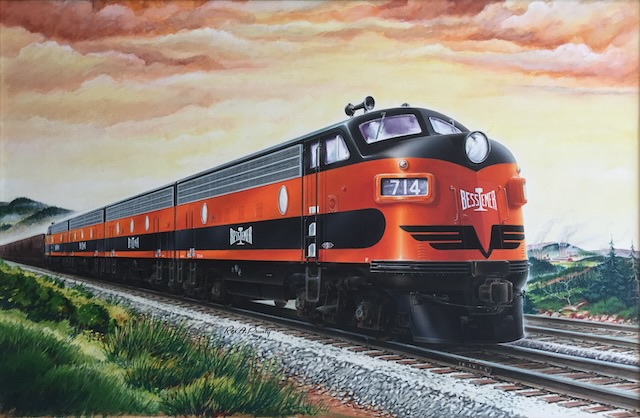The past few weeks have presented art by Leland Knickerbocker, Paul Meyer, Ben Dedek, and Harry Bockewitz, plus one data card whose painting was by Rex A. Prunty. Among images of original artworks provided by Greg Palumbo are three other paintings signed Rex A. Prunty plus I’ve found on-line evidence of a fourth painting.

Click any image for a larger view. Click here to download a 2.9-MB PDF of all three paintings shown here. The size of the images in this PDF is based on the resolution of the original images, not the actual size of the paintings in inches.
Prunty was born in Illinois in 1899 and may have worked for GM Art and Color; his name is on a drawing of a race car from the 1940s. The above F3 locomotive was delivered in November 1948, so by that date he would have been working for EMD Styling.
The locomotive shown in the above painting is a BL2, known as the “Diesel that didn’t” because it sold so poorly. It was intended to serve as a road switcher but didn’t have outside walkways for the switch crew. The GP7 that replaced it had such walkways and sold very well. Bangor and Aroostook was one of just nine buyers of the BL2, which was manufactured between 1947 and 1949. Number 50 was made in March 1949.
Bessemer & Lake Erie 714 was one of 54 F7s purchased by the railroad, and not the first (which was 701). Number 714 was manufactured in March 1951. I’ve also seen a small image of a Bessemer & Lake Erie GP7 attributed to Prunty.
These paintings may have been used on data cards, but I don’t have cards for any of these locomotives so I don’t know for sure. The data card I have whose painting is by Prunty was for a locomotive that delivered in January 1951.
I do know that Prunty married Margaret English in 1941, when Prunty would have been almost 42 years old. Although both were from Illinois, for some reason they got married in Seattle. Supposedly Prunty worked for an aircraft manufacturer in 1940; perhaps it was Boeing. But they must have been back in Illinois from 1948 to 1952 for him to work for EMD.
In late 1952, Prunty and his wife moved to Albuquerque, where Prunty went to work for the Sandia Corporation. Sandia was owned by AT&T and contracted by the federal government to manage Sandia National Laboratories, which did and continues to do research on nuclear energy and other high-tech subjects.
Prunty presumably did artwork for Sandia, and he must have also done some drawing on an amateur basis. A painting of a Sioux warrior by Gerard Curtis Delano, some of whose were purchased by Santa Fe, is inscribed, “for Rex A. Prunty from a sketch by Rex A. Prunty.”
Prunty died in Albuquerque in 1980. Although that’s all I can find about him, it is actually a little more than I’ve found about most of the other GM artists.


